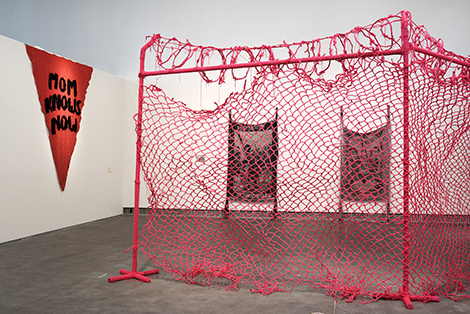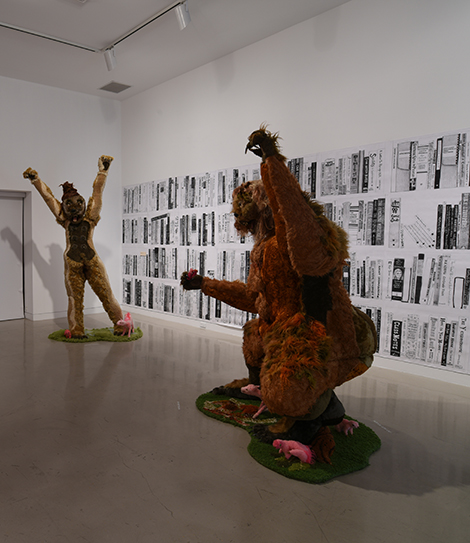Your cart is currently empty!
“Alien She”

The Riot Grrrl movement, which emerged in reaction to the male-dominance and sexism that infused West Coast punk scenes in the 1990s, spawned a subcultural movement in art, publishing, and performance. Even in the resolutely anti-establishment punk rock scene, many male-fronted bands spouted homophobic lyrics and ideologies. Riot Grrrl musicians and artists stood against the widespread homophobia and conservatism in the punk scene and society as a whole.
“Alien She” at the Orange County Museum of Art focuses on seven artists who were influenced by the Riot Grrrl movement. This narrow survey immediately bombards viewers with a montage of roughly-printed punk rock zines. The visual magnitude of this archive, safely cached behind a layer of Plexiglas is overpowering, offering an initial impression of the breadth and intricacy of this subculture. One shelf holds a small sample of zines, allowing readers to peruse a few copies, but feelings of cacophony and hermeticism echo throughout the entire exhibit, which as a whole is visually and contextually disjointed.

Tammy Rae Carland’s 2002 “Lesbian Beds” series provides an intimate view of the sexuality negatively targeted by the male-centered mainstream punk. Her serene studies of lesbian couples’ unmade beds serve as a counterpoint to the chaotic energy of the zine archives, but the discordant punk aesthetic is a continuous theme in “Alien She.” L.J. Roberts’ giant, bright pink crocheted “barbed wire” fence in the center of the exhibit—not actually barbed wire, but made of yarn, hand-woven wire, steel poles, and assorted hardware—“We Couldn’t Get In. We Couldn’t Get Out” (2006-7) is an abrasive and disarming visual presence. In her hands, this warped and messy structure that stretches diagonally across an entire gallery, splitting the space in two becomes a metaphor for the struggle of immigrants, queer and transgendered people.
Allyson Mitchell explores non-normative sexuality, positing a “queer utopian dream world” with giant female monsters from her “Ladies Sasquatch” series (2006–10) near the giant pink fence. These large, ferociously posed fuzzy creatures recalibrate ideas of beauty, desire and femininity.
Stephanie Syjuco’s “The Counterfeit Crochet Project (Critique of a Political Economy)” series (2006–present) of replicated designer handbags, belts, pouches and other consumer accessories invite dialogue about the elevated value of art, how the setting of an object changes its value, and whether material choice changes that value. In line with the Riot Grrrl movement’s collaborative and supportive tendencies, the series comes complete with free instruction manuals. Syjuco’s collaborative-based works offer an interesting dialogue about authorship, commodity, and the ongoing debate about art vs. craft.
The work of Miranda July, whose boundary-pushing is often compelling, loses out in this installation, which is sparse and heavy on text. With such strong video-based and interactive works, it is a pity the museum offered documentation of pieces and processes, rather than finding a creative way to exhibit some of her most interesting pieces. July’s video works on display here are small and of poor quality. While they draw on a kind of vintage aesthetic, they fall flat in this space.
One high point for the exhibit is the collection of photographs and video clips from filmmaker and artist Faythe Levine. Her Handmade Nation and Sign Painters films are fascinating and beautifully executed alternative art scene documentaries. However, the presence of these films in “Alien She” is confusing. While the curator notes that Levine is influenced by the activism of the Riot Grrrl movement, there is little resonance of Riot Grrrl motives in Levine’s work for this exhibit.
The exhibition seems afflicted with a mild case of schizophrenia, teetering back and forth between a larger cultural survey of the Riot Grrrl movement and a simple look at seven artists who were influenced by the underground Riot Grrrl movement in the 1990s. At times, the visual representation of the movement and artists is chaotic and overwhelming rather than illuminating. Based on an aggressive underground punk rock music scene that was formed as a reaction to sexism, racism and homophobia, a large number of women at that time became more active and aggressive in art, politics, music and activism, standing up for LGBT and women’s rights and experiences.
“Alien She,” which is part of a national tour, feels cramped in the OCMA galleries. The exhibition as a whole seems like it would make a fascinating book, but with the majority of the works being so based in documentary and social practice, the experience as a whole is educational, sometimes evocative, interesting but exhausting.